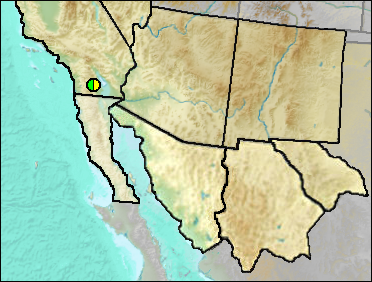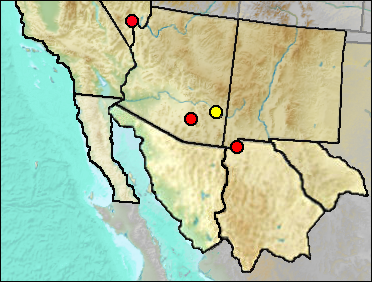Class Reptilia
Order Squamata
Suborder Sauria
Family Helodermatidae

The Coyote Badlands record is based on an osteoderm recovered during matrix washing (Gensler 2001).
Sites.
Late Irvingtonian: Coyote Badlands, Anza-Borrego Desert (Gensler 2001).
Literature. Gensler 2001.


The current range of the Gila Monster is primarily Sonoran Desert, although its range does extend into southwestern New Mexico.
Fig. 1. Gila Monster (Heloderma suspectum). Photograph by Jeff Servoss, U.S. Fish & Wildlife Service.
A right dentary (Fig. 2) was recovered from the mid Wisconsin deposits of U-Bar Cave. This site currently is near the edge of the geographic range of this large, poisonous lizard.
Mead (2005) notes that there is not adequately dated recovery in Arizona to affirm its presence in the last glacial. There appears to be conflicting chronologic data from Vulture Cave, and it is not recorded below.

Fig. 2. Medial (top) and lateral views of the right dentary of Heloderma suspectum from U-Bar Cave, Hidalgo Co., NM.
Sites.
Latest Blancan 111 Ranch (Mead et al. 2015).
Mid Wisconsin: U-Bar Cave (Harris 1993c).
Late Wisconsin: Gypsum Cave (Brattstrom 1954).
Late Wisconsin/Holocene: Deadman Cave (Mead et al. 1984).
Literature. Harris
1993c; Mead 2005; Mead et al. 1984; Mead et al. 2015.
Last Update: 6 Oct 2019